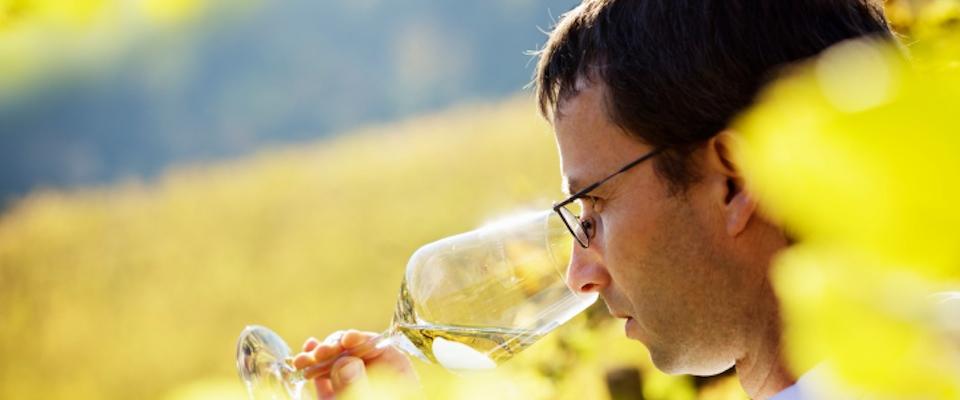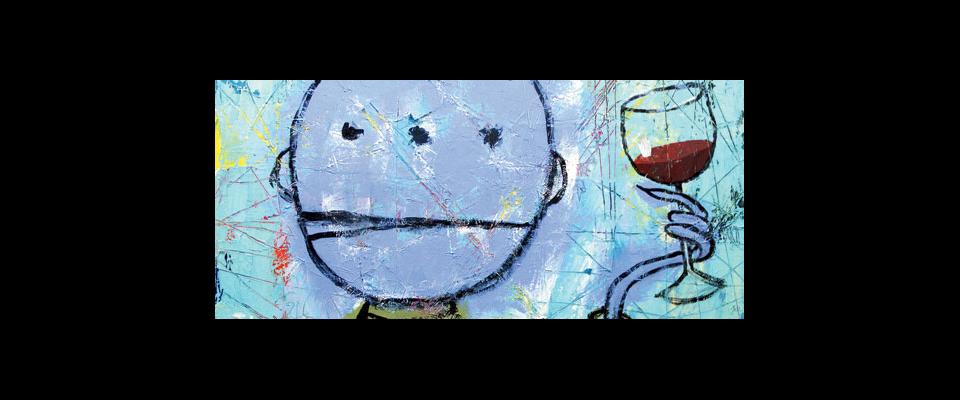You’re at an international dinner party, with friends from France, Italy, and China. Someone opens a bottle of wine. After a sip, you say, “That’s a big red, with strong blackberry and raspberry flavors. It’s delicious!”
Your neighbors disagree with you on the verdict. The Chinese guest is confused by the description, while the French and Italian guests are put off by the association of wine and fruit. That’s how it is with food and wine: Different cultures relate differently to what they eat and drink. But there is something going on here that is beyond personal preferences, because wine appreciation is not all in the taste buds. Linguistics plays a considerable role.
In any research field, it’s hard to separate the influences of language and culture. This is particularly difficult in food and wine, because what little research money is available has tended to go toward the most practical applications, such as how to make better wine.
A key theory of linguistics, though, is that of linguistic relativity: The structure and syntax of a language affect the way its speakers experience the world. So language itself, not just culture, might cause speakers of different tongues to perceive the wine differently.
Robin Lakoff of the UC Berkeley linguistics department, one of the world’s leading scholars on this topic, described the concept by comparing the ways in which German and French people speak about bridges. “The word for bridge in French is masculine,” Lakoff said. “The word for bridge in German is feminine. Normally we think gender doesn’t have a lot to do with meaning; a bridge is a bridge.” But studies show that “French speakers said bridges are strong; they are powerful,” Lakoff said. “Germans were more likely to talk about the delicacy of the cables or the artistic beauty of a bridge.”
If our primary language has such a powerful effect on our perception of an object we see every day, imagine its effect on something as ethereal as the taste of a wine.

The word for wine is masculine in gender in the languages of all major European wine-producing countries. However, you can see the impact of gender in American wine reviews. Words like “muscular” and “powerful” tend to be associated with the highest ratings from critics, while “pretty” and “elegant”—seemingly desirable qualities in a wine—are rarely used on the very top-rated wines.
Consumers, too, display gender preferences in describing wines. In 2005, the Internet research organization Wine Opinions of St. Helena surveyed U.S. consumers about their choices for terms used to talk about cabernet sauvignon. Men preferred “heavy and full-bodied”; women wanted “jammy fruit.”
As an American English speaker and certified wine professional, I have been trained in part by Berkeley alumna Ann Noble, who in 1984 developed an “aroma wheel” to standardize descriptions of olfactory and taste sensations in wine.
The aroma wheel uses a comprehensive list of possible wine descriptors in 12 categories. The large category of “fruity,” for example, leads to subcategories including tree fruit, dried fruit, berry, and citrus. These in turn have specific subcategories such as apple, fig, cherry, and grapefruit. Other primary categories include woody, nutty, herbaceous, and floral. The idea is that a taster, instead of saying, “It smells like perfume,” will zero in on more exact sensations and say, “It smells like orange blossom with a hint of eucalyptus.” Thus a reader who knows those scents can understand exactly what is meant in the description.
Before Noble’s breakthrough, English speakers tended to describe wines by comparing them with other wines, as in “The 1978 Cheval Blanc is most like the ’72, though it has some characteristics of the ’68.” Not only does this exclude novices who aren’t familiar with those vintages, but it doesn’t really describe the wine at all. Another common pre-Noble description, still popular with amateur critics, is to make celebrity analogies. A famous one from a magazine called Wine X was “Tastes like Brad Pitt stepping out of the shower.”
Like most sommeliers, I investigate each wine like a bloodhound, trying to tease out whether I’m smelling peach or apricot. Instead of Brad Pitt, I use approved aroma-wheel words such as “sweaty,” “tobacco,” “cloves,” and “wet wool.” This “fruit-bowl” approach to describing wines reaches its apotheosis in Robert Parker, a lawyer who became the world’s most influential wine critic.
Let’s imagine three red wines: a typical Napa Valley wine; a French red wine from the Loire district; and an Italian red from Campania. Parker would describe the fruits he tasted in these hypothetical wines, but most importantly, he would give each a numerical rating on a 100-point scale. For many Americans, that’s all they need to know.
“It’s an attempt to re-scientize,” Lakoff says. “Nobody knows what ‘nose’ means, or what ‘terroir’ means. But we all know what 94 means. We all agree that 94 is more than 93.”
Back at the party, let’s say I describe my Loire red as having herbal flavors, like “artichoke” or “tea,” which don’t sound as delicious to Americans as “jammy, ripe blackberry” and would almost certainly lead to a score under 90 from Mr. Parker. But the French-speaking taster next to me might be experiencing the same flavors entirely differently, says Dr. Mairi McLaughlin from the Berkeley French department. “In California, I associate wine with grapes,” McLaughlin says. “Drinking a wine in France, you’re imagining the place.” In other words, while the American is thinking about smoke or citrus, the French drinker is thinking about the regions of Burgundy or Bordeaux. American prose “is much more direct,” she adds. “The language in France is more metaphorical.”
This is a typical Robert Parker review, of a California wine called Palazzo 2006: “Reveals a sumptuous perfume of white chocolate, fruitcake, black cherries, black currants, and subtle toasty oak. Displaying a luscious texture, a broad, savory midpalate, and gorgeous length, it should drink nicely for 10 to 15+ years.” In contrast, La Revue du vin de France is the most serious of France’s wine publications, but it still has space for a review like this, of a Paul Beucher wine: “Classic of an Alsatian-style pinot noir that seduces by its tender side.”
Perhaps my French friend will not be seduced by my American wine.

When I get to the Campania wine, I notice that it has much stronger acidity than the other two. As a wine writer, I struggle every week with a way to make that word—”acidity”—sound like a positive to my American readers. “Food friendly” is one dodge, because the 2005 Wine Opinions survey found that the second most negative descriptor for Americans is “crisp or tangy with distinct acidity.” (The worst phrase to Americans was “dry and tannic.”)
The Italian speaker would be more likely to say “acidic” as praise, or even to confound his American neighbor by describing the wine as “sour” while appearing to like it.
“‘Sour’ in wine in English can be said to be a lack of ripeness, which is a negative,” says Rachel Black, director of the Boston University Gastronomy program and a frequent guest lecturer in Italy. “In Italy it’s not stigmatized. There’s not so much of a desire for sweetness.” In contrast, Americans dislike “sour” so much that it wasn’t used frequently enough to even be included in the Wine Opinions survey.
Italian and French also share a grammatical construction that McLaughlin says has a huge impact on the way their speakers think about wine.
In the United States, if a wine is called “easily drunk,” it’s generally thought of as a cheap wine, not at the level of great wines. But in this quirky Italian and French syntax, “the equivalent is ‘the wine drinks itself'” says McLaughlin. “It’s talking about the very nature of the wine, as opposed to the experience of the drinker.” And a wine that drinks itself is a very positive characteristic—imagine laundry that does itself—as opposed to the passive description “easily drunk.”
Our Chinese guest has been sitting quietly at the table, with his own thoughts about the wines. What might they be? I asked Qingyun Ma, dean of the University of Southern California School of Architecture and founder of a winery in China. To begin with, he’s not thinking about raspberries and olallieberries, which most Chinese have never tasted.
When Ma wants a Chinese person to have a positive impression of a wine, he uses words for taste sensations, which often have no corollary in English. For example, it is important to talk about mouth feel, because Chinese people take that very seriously in food—so much so that they can describe mouth feel in ways that Americans have never even considered. “There is a word, suan, that has a very specific definition,” Ma says. “You could translate it like a spicy or chemical reaction in your mouth. But those words cannot translate back into Chinese.” You wouldn’t want a wine to have suan, but you would want to use very specific words about how it feels in the mouth. English speakers, though, are generally limited to “silky and smooth” or the unpopular “dry and tannic.”

Linguistic relativity comes into play in many words that wineries of other countries use when selling wines in China. Even if words like “sweet” and “fresh” translate directly into Chinese, the connotation is different, with huge implications for how a wine is perceived. “Sweet,” for example, is not a positive unless the speaker says where the sweetness comes from. But “fresh,” not a word often used for wine in the United States, has different connotations in China.
“The word xian, if you translate directly, would be new and fresh,” Ma says. The word might not have a flavor association, but, he says, “xian in China has a very direct connotation to the origin. It’s very vibrant and healthy.”
Let’s say our Loire red is a few years old and has some of the secondary characteristics of age. We would have to choose our words very carefully if we want our Chinese friend to try it.
“If you say a wine tasted like leather, they don’t want to put that in their mouth,” Ma says. “If you say ‘barnyard,’ they think of cow manure, and that would turn them off immediately.” Yet both these terms are widely used and are understood to be positive attributes by European wine connoisseurs, and to a lesser extent by American ones as well.
Let’s go back to the beginning of this story. I wrote: “That’s a big red, with strong blackberry and raspberry flavors. It’s delicious!” Our Chinese friend doesn’t understand the fruits. Our French friend wonders where the land is, and why those fruits are appealing. And our Italian friend may be bewildered by the adjective “big,” which pops up in every American wine publication.
“What do you mean by ‘big’?” Lakoff asks. “It’s the same size as any other wine. What does it mean to say a liquid has size?”
I would love to end this article by describing a wine in such a way that the guests from all four countries would understand. But not only are we not speaking the same language; we may not even be having the same experience.
Now just imagine the fun when I pull out a New Zealand sauvignon blanc, frequently described in England as having the aroma of “cat pee.” Perhaps I’d better just let everyone taste it and keep my description to myself.




















